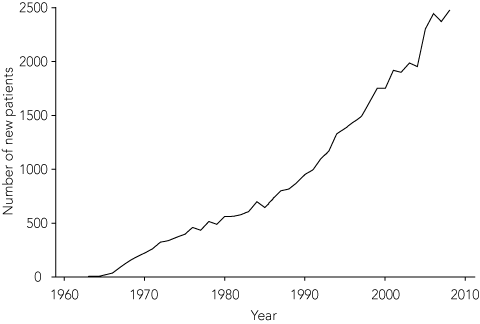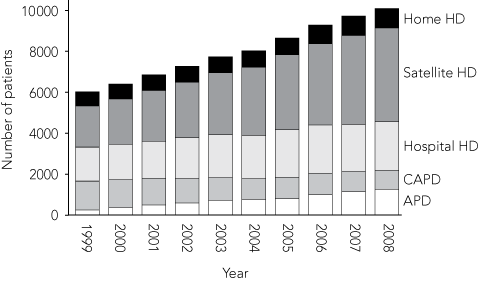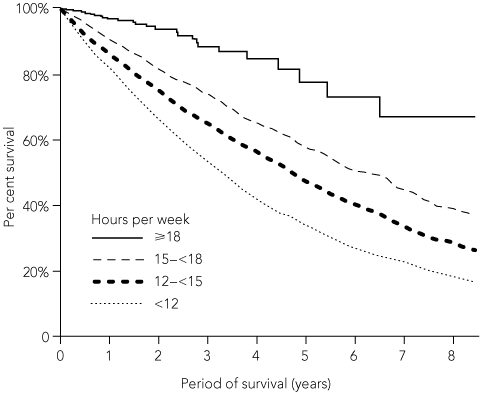Chronic kidney disease (CKD) is a significant and growing public health problem that is responsible for a substantial burden of illness and premature mortality. A recent Australian estimate has suggested that about one in three adult Australians is at increased risk of developing CKD and that one in seven has at least one clinical sign of existing CKD.1
The incidence and prevalence of both CKD and the management of end-stage kidney disease (ESKD) by dialysis and transplantation have been increasing over the past 40 years (Box 1).2 At the end of 2008, more than 17 500 Australians were receiving some form of renal replacement therapy (renal transplantation or dialysis), and 10 000 of these were undergoing dialysis.2 This growth is attributed primarily to two factors: an ageing population and the increasing prevalence of type 2 diabetes.
Comprehensive costing of the economic burden of dialysis in Australia (in 2004 dollars) indicates that the annual health care cost of ESKD in 2010 will be between $800 million and $900 million.3 This represents an increase of about 50% from 2004. Moreover, there are other indirect physical, psychosocial, and economic costs, which can result in significant financial, vocational, educational, and emotional pressures for individuals, their families and the wider community.
Although kidney transplantation is the most effective treatment for ESKD, currently only 16% of all dialysis patients are medically suitable and on the national transplantation waiting list, reflecting in large part the increasing age and comorbidity of dialysis patients. A shortage of organs from deceased donors also means the waiting time on dialysis for a deceased donor transplant has progressively risen and is now typically about 4–7 years. Although a kidney may also be received from a live donor (eg, a relative or friend), live donation currently only accounts for about 40% of all kidney transplantation in Australia.2
About a third of Australians using HD attend a hospital for their treatment (Box 2).2 Although in-centre HD allows for constant clinical monitoring and treatment support, there are potential disadvantages. Its costs are higher than those at alternative dialysis locations and, for most people, the constant medical supervision available in hospital-based units is unnecessary. In addition, hospital environments can be dehumanising, promoting institutionalisation and loss of self-determination — factors clearly shown by quality-of-life data to be linked to poorer patient outcomes. In-centre dialysis also enforces strict treatment schedules and requires thrice-weekly travel (sometimes difficult, arduous and expensive) to and from the in-centre unit.
As an alternative to in-centre dialysis, treatment can be undertaken at a satellite centre — a regional hospital or community-based dialysis unit distant from the “parent” tertiary hospital unit. Treatment is provided by trained nurses, and nephrologist care is often distant or periodic. The proportion of people undertaking dialysis in satellite centres has been increasing steadily in recent years (Box 2). Although satellite dialysis originally involved a component of “self-care” (eg, machine set-up and/or self-needling), it now more commonly simply represents dialysis at a site less “acute” than a tertiary hospital, with patients doing less self-care and being more dependent on nursing and other health care workers in these centres. Similar to in-centre dialysis, treatment schedules are usually fixed, and travel to and from the unit may be problematic for patients.
In the mid 1970s, home HD accounted for nearly half the patients on dialysis in Australia but, by 2000, only 12% of the HD population were undertaking therapy at home.2 As the proportion using home HD fell, PD flourished and became the more common home therapy.
There are two variants of PD: continuous ambulatory PD (CAPD), where the dialysis exchanges required 4–5 times daily are performed manually; or automated PD (APD), where a PD machine “cycles” dialysate automatically while the patient sleeps. As the manual exchanges of CAPD can be performed in any clean, quiet and convenient environment, and APD is performed by a small bedside machine during sleep, both PD methods are provided as home therapy. From a peak in 1995 of more than 35% of dialysis patients using PD at home, this proportion fell to 27% in 2000 and 22% in 2008 (Box 2).
Although HD was also a successful home therapy, by the early 2000s less than 10% of all people on dialysis in Australia were undertaking HD at home. The major reason for the attrition in home HD was the growth in community satellite centres staffed by dialysis-trained nurses, despite their greater cost and schedule restrictions. In recent years, there has been a resurgence in home HD and major changes in home HD treatment regimens in Australia, with significantly more of these patients performing dialysis more frequently and for longer sessions. These changes have primarily been made possible by the introduction in 2000 of nocturnal home HD, where HD is performed while patients are asleep.4 It is hypothesised that much of the enthusiasm now surrounding home HD can be attributed to growing interest in nocturnal home HD.
The fiscal and lifestyle advantages of home dialysis therapies include enhanced opportunities for rehabilitation and a return to employment, no requirement for patients or families from remote areas to move, and no time and cost issues associated with dialysis transport. Moreover, observational studies report increased patient satisfaction and improved quality of life.5-8
The Australia and New Zealand Dialysis and Transplant Registry (ANZDATA) has captured data on all dialysis and transplant patients in Australia and NZ for over 30 years. Observational data derived from this registry suggest a significant survival advantage for increased hours of dialysis per week, with the most benefit from 18 or more hours weekly (Box 3).9 Conventional in-centre and satellite HD is performed for a mean of 4.5 hours three times weekly. There is also a survival benefit for people who dialyse more frequently, with those able to dialyse to an alternate-day schedule (ie, seven treatments per fortnight or “3.5 treatments per week”), or even more frequently, having better 5-year survival than those on conventional three-times weekly HD.9 An alternate-day schedule has the advantage of eliminating the long break over the weekend, avoiding excess solute and especially fluid accumulation. These data suggest that two characteristics that are common in home HD because they can be more readily practised at home (particularly as nocturnal HD) — longer hours and higher frequency — are associated with improved survival.
Home HD has been shown to be cheaper than other forms of HD and to require fewer medical and nursing staff, and no infrastructure, plant and dialysis facilities. Australian economic data have been published that support the cost-effectiveness of home dialysis therapies. Using the Victorian funding model for calculating dialysis costs, it has been demonstrated that, compared with conventional satellite HD, even 6 nights per week of nocturnal HD represented an annual saving of 10.75%.10 The Victorian funding model is a robust approach that has evolved over three iterations and has repeatedly demonstrated that home HD is the cheapest dialysis modality.11 On the other hand, home PD modalities are similar in cost to satellite HD.
An economic analysis using Markov modelling, and based on the best available published Australian data, was undertaken in 2006 for new patients commencing renal replacement therapy, and projected to 2010. It showed that if the proportion of patients undertaking home therapies could be increased in every state to the current level achieved by the top-ranked state for each of home HD and home PD — and the proportion undertaking dialysis in hospital and satellite settings could be correspondingly decreased — savings of up to $135 million out of an annual national budget of $560 million could be achieved.3
There is considerable variation in use of home dialysis modalities (PD and HD) between the Australian states and territories.2 Reported use of home HD is highest in New South Wales, at 15% of the dialysis population. Conversely, South Australia, Western Australia and the Northern Territory report rates of 1%–5%. In NSW, 28% of the dialysis population use PD, compared with 17% in Victoria. The reasons for this variation are unclear but relate in part to historical models of the delivery of care.
There are a number of real and perceived barriers to home HD. With the increasing age of patients (average age at inception of dialysis is now 65 years), it may be unrealistic to expect many older people to self-care at home. However, it must be stressed that there are a number of older patients in home HD programs, while PD is already commonly learnt and practised at home by older people. The increasing comorbidity of dialysis patients is an inescapable limitation on the uptake of home therapies. Serial ANZDATA reports show the growth of diabetes as a comorbidity, now affecting more than 40% of Australian dialysis patients.2 Where comorbidities can be managed with home dialysis by well supported and resourced programs, patients can be sustained at home — commonly to their satisfaction and at a lesser cost burden to the health system as a whole.
The complexity of older HD systems is seen as a disincentive for training and sustaining patients at home. As equipment is progressively simplified, home HD will become a more attainable goal. In the United States, the appearance of the NxStage System One (NxStage Medical, Lawrence, Mass, USA)12,13 — a smaller, portable, user-friendly dialysis machine — has led to a keen interest in home HD and a sharp rise in the uptake of home-based, short, daily dialysis.14 Although as yet unavailable in Australia, this machine, and others like it in development, will make self-administered home HD easier in the near future.
The use of home dialysis varies dramatically between countries. Recent data show that Australia has a high rate of PD use compared with other Organisation for Economic Co-operation and Development countries and is second only to NZ for home HD.15
A study using registry data from 2001 to 2003 similarly demonstrated dramatic variation in the prevalence of home HD between countries.16 Factors considered likely to be responsible for the variation — health care expenditure, population density, or prevalence of kidney transplantation — were found to show no consistent relationship with uptake of home HD. The uptake of home HD was by far the greatest in Australia and NZ. Although the large size and sparse population of Australia are frequently cited as the reasons for its high uptake of home therapies, Australia is one of the most highly urbanised nations in the world17 — a factor that might be expected to reduce rather than increase the rate of home dialysis. Perhaps expertise in and commitment to home-based dialysis, both HD and PD, are the more important reasons for the difference.
With the increasing cost of dialysis to the community and in the face of a static transplantation rate, approaches that reduce the financial and social impact of dialysis therapies should be embraced by funding agencies. In this regard, the Victorian Government has led the way by introducing funding models that provide an incentive to use home dialysis.11 These policies are to be applauded and other state and federal authorities should be encouraged to emulate them.
1 Number of new patients commencing renal replacement therapy (dialysis or transplantation) in Australia, 1963–2008*
 | |||||||||||||||
|
* Figure adapted with permission from the Australia and New Zealand Dialysis and Transplant Registry 2009 Report.2 | |||||||||||||||
2 Method and location of dialysis* in Australia, 1999–2008†
- John W M Agar1
- Carmel M Hawley2
- Charles R P George3
- Timothy H Mathew4
- Stephen P McDonald5
- Peter G Kerr6
- 1 Geelong Hospital, Geelong, VIC.
- 2 Princess Alexandra Hospital, Brisbane, QLD.
- 3 Concord Repatriation General Hospital, Sydney, NSW.
- 4 Kidney Health Australia, Adelaide, SA.
- 5 ANZDATA Registry, Queen Elizabeth Hospital, Adelaide, SA.
- 6 Monash Medical Centre, Melbourne, VIC.
Special thanks to Brian Livingston at the ANZDATA Registry for his help with preparation of the graphs presented in this article. The ANZDATA Registry receives funding from the Australian Government Department of Health and Ageing, the NZ Ministry of Health, and Kidney Health Australia. General support for Registry activities has been received from Amgen Australia, Novartis Pharmaceuticals Australia, Janssen-Cilag, Fresenius Medical Care Australia, Roche Products and Wyeth Australia. There was no special funding for the preparation of the work presented in this article.
Peter Kerr has consultancies with Fresenius and Baxter, manufacturers of home haemodialysis products. Stephen McDonald has received speaker fees from Baxter and Fresenius, and Carmel Hawley has received a travel grant from Fresenius to attend a sponsored meeting.
- 1. Chadban SJ, Briganti EM, Kerr PG, et al. Prevalence of kidney damage in Australian adults: the AusDiab kidney study. J Am Soc Nephrol 2003; 14 (7 Suppl 2): S131-S138.
- 2. Australia and New Zealand Dialysis and Transplant Registry. The 32nd annual report: ANZDATA Registry 2009 Report. Adelaide: ANZDATA Registry, 2009.
- 3. Cass A, Chadban S, Craig J, et al. The economic impact of end-stage kidney disease in Australia. Melbourne: Kidney Health Australia, 2006.
- 4. Agar JWM. Nocturnal haemodialysis in Australia and New Zealand. Nephrology (Carlton) 2005; 10: 222-230.
- 5. National Institute for Health and Clinical Excellence. Final appraisal determination: the clinical and cost effectiveness of home compared with hospital haemodialysis for patients with end-stage renal failure. London: NICE, 2002. http://www.nice.org.uk/guidance/index.jsp?action=article&o=32448 (accessed Feb 2010).
- 6. Kutner NG, Zhang R, Barnhart H, Collins AJ. Health status and quality of life reported by incident patients after 1 year on haemodialysis or peritoneal dialysis. Nephrol Dial Transplant 2005; 20: 2159-2167.
- 7. Mowatt G, Vale L, MacLeod A. Systematic review of the effectiveness of home versus hospital or satellite unit hemodialysis for people with end-stage renal failure. Int J Technol Assess Health Care 2004; 20: 258-268.
- 8. Juergensen E, Wuerth D, Finkelstein SH, et al. Hemodialysis and peritoneal dialysis: patients’ assessment of their satisfaction with therapy and the impact of the therapy on their lives. Clin J Am Soc Nephrol 2006; 1: 1191-1196.
- 9. Kerr PG, Polkinghorne KR, McDonald SP. Home hemodialysis in Australia: current perspective. Hemodial Int 2008; 12 Suppl 1: S6-S10.
- 10. Agar JWM, Knight RJ, Simmonds RE, et al. Nocturnal haemodialysis: an Australian cost comparison with conventional satellite haemodialysis. Nephrology (Carlton) 2005; 10: 557-570.
- 11. Victorian Maintenance Renal Dialysis Program. Funding model – general information. http://www.health.vic.gov.au/renaldialysis/funding.htm (accessed Jan 2010).
- 12. Floramo S. Use of the NxStage System One for daily home hemodialysis. Nephrol News Issues 2006; 20 (11): 48-50, 52-53.
- 13. NxStage Medical. Home Hemodialysis Data Registry: overview. http://www.nxstage.com/chronic_renal_care/registry/overview.cfm (accessed Jan 2010).
- 14. Lockridge RS Jr, Pipkin M. Short and long nightly hemodialysis in the United States. Hemodial Int 2008; 12 Suppl 1: S48-S50.
- 15. United States Renal Data System. USRDS 2007 annual data report: atlas of chronic kidney disease and end-stage renal disease in the United States. Bethesda, Md: National Institutes of Health, National Institute of Diabetes and Digestive and Kidney Diseases, 2007.
- 16. MacGregor MS, Agar JWM, Blagg CR. Home haemodialysis — international trends and variation. Nephrol Dial Transplant 2006; 21: 1934-1945.
- 17. The World Bank. 2007 World development indicators. 3.10: urbanization. http://siteresources.worldbank.org/DATASTATISTICS/Resources/table3_10.pdf (accessed Mar 2008).







Abstract
In the mid 1970s, home haemodialysis accounted for nearly half of all patients on dialysis, both in Australia and elsewhere.
The advent of both peritoneal dialysis (itself a home therapy) and satellite haemodialysis resulted in a gradual attrition in the use of home haemodialysis.
Since 2000, the introduction of nocturnal home haemodialysis has begun to change this pattern in Australia, with a sharp growth in the uptake of home haemodialysis.
Home haemodialysis, which enables longer hours and more frequent treatments than facility-based (hospital or satellite centre) dialysis, appears to offer improved patient outcomes in observational studies; randomised studies are necessary to confirm these findings.
Home haemodialysis is also a cheaper form of therapy than facility-based dialysis.
As newer, simpler and more user-friendly equipment is emerging that will make home haemodialysis even more accessible and attractive to the consumer, we believe that this trend toward a greater uptake of home haemodialysis should and will continue.